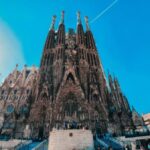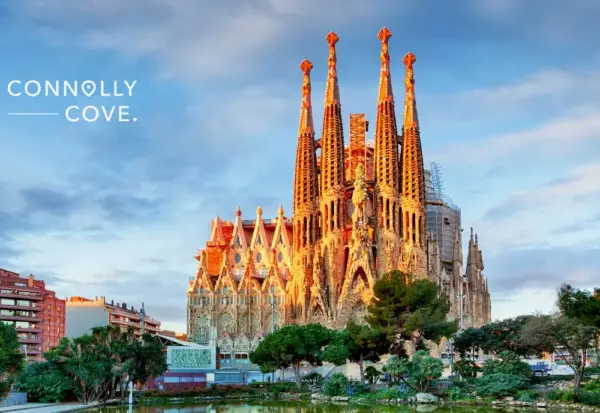
Barcelona, a city known for its rich artistic heritage, boasts one of the most iconic structures of modern architecture: the Sagrada Familia. This basilica, designed by the visionary Antoni Gaudí, is not just a place of worship but a testament to creativity and devotion, attracting millions of visitors each year.
In this guide, we invite you to embark on a journey of discovery, **Exploring the Majestic Sagrada Familia in Barcelona's Vibrant District | Travel Guide**. From its awe-inspiring façades to the intricate details of its interiors, the Sagrada Familia promises an unforgettable experience that captures the heart and soul of Barcelona.
Discovering Gaudí's Architectural Genius: The Sagrada Familia Unveiled
As you step into the world of Gaudí's architectural genius, the Sagrada Familia reveals its unique blend of natural forms and spiritual symbolism. The basilica's design includes a myriad of shapes inspired by nature, with towering columns resembling trees and intricate facades that tell biblical stories. This harmonious integration of art and faith makes every corner of the Sagrada Familia a visual delight.
One of the most striking features of the basilica is its dynamic play of light. The stained glass windows, crafted with a spectrum of colors, transform sunlight into a kaleidoscope of hues that dance across the interior. Visitors can experience this ethereal quality by exploring the various nave sections, each designed to evoke different emotions and reflections. Here are a few highlights:
- The Nativity Facade: A celebration of Christ's birth with intricate carvings.
- The Passion Facade: A stark contrast, embodying the suffering of Christ.
- The Glory Facade: An awe-inspiring representation of Christ's resurrection.
Additionally, Gaudí’s meticulous attention to detail is evident in the basilica's façade sculptures and interior motifs. Each sculpture serves a purpose, often portraying religious figures or scenes, and is meticulously crafted to enhance the spiritual experience. The combination of geometry and organic design showcases Gaudí's innovative approach, making the Sagrada Familia a true masterpiece of modernist architecture.
As construction progresses towards its anticipated completion, the Sagrada Familia remains a symbol of Barcelona's cultural identity. Visitors not only admire its architectural grandeur but also become part of an ongoing story—a narrative driven by human creativity and ambition. Engaging with this monumental work of art encourages a deeper appreciation of Gaudí's vision and the collaborative effort that brings it to life.
A Journey Through Time: The History of the Sagrada Familia in Barcelona
The history of the Sagrada Familia is as intricate and captivating as its design. Construction began in 1882 under architect Francisco de Paula del Villar, but it was Antoni Gaudí who took over the project in 1883, infusing it with his unique vision. Gaudí dedicated over 40 years of his life to the basilica, transforming it into a symbol of faith and artistic expression that reflects his deep commitment to both architecture and spirituality.
One of the remarkable aspects of the Sagrada Familia's history is its continued construction, which has spanned over a century. Due to Gaudí's innovative methods and the complexity of his designs, the project has faced numerous challenges, including financial constraints and the Spanish Civil War. Despite these setbacks, the basilica has evolved, showcasing a blend of Gothic and Art Nouveau styles that captivates all who visit.
Today, the Sagrada Familia stands as a testament to human perseverance and creativity. The ongoing construction is guided by Gaudí's original plans and modern techniques, aiming for completion around 2026, coinciding with the centenary of Gaudí's death. This timeline allows visitors to witness a living piece of history, where each stone laid reflects a chapter in the story of Barcelona's architectural heritage.
As you explore the Sagrada Familia, you can appreciate not only its physical beauty but also the rich narrative woven into its structure. This extraordinary basilica is a fusion of art, faith, and time, drawing millions to experience its spiritual and cultural essence. Here are a few key milestones in its history:
- 1882: Groundbreaking ceremony led by Francisco de Paula del Villar.
- 1883: Antoni Gaudí becomes the chief architect.
- 1936: Construction halts due to the Spanish Civil War.
- 2026: Projected completion date, marking 100 years since Gaudí's death.
Exploring the Unique Design Elements of the Sagrada Familia
The Sagrada Familia is renowned for its extraordinary design elements that embody a blend of artistic innovation and natural inspiration. Antoni Gaudí's vision is evident through organic shapes that mimic natural forms, creating a unique architectural language. Key design elements include:
- Tree-like Columns: These support the basilica’s roof while resembling a forest, enhancing the experience of walking through a sacred space.
- Hyperboloid Structures: Utilized in the towers, these shapes not only serve structural purposes but also symbolize the connection between the earthly and the divine.
Another striking feature of the Sagrada Familia is its intricate façades, each narrating a different aspect of Christian theology. The façades are designed with deep symbolism and artistic detail, drawing visitors into a spiritual narrative. Notable aspects include:
- Symbolic Carvings: Each element, from flora to figures, tells a story, reflecting Gaudí’s deep religious beliefs.
- Light Play: The careful arrangement of shapes creates an interplay of light and shadow, enhancing the emotional atmosphere inside the basilica.
Gaudí also employed a rich palette of colors in the stained glass windows, which transform light into vibrant patterns that evolve throughout the day. This dynamic quality adds layers of meaning, inviting contemplation and reflection. Visitors can observe:
- Color Gradients: These change with the sun's movement, creating a living artwork that animates the interior.
- Symbolic Colors: Each hue is chosen for its spiritual significance, enhancing the overall experience of the sacred space.
In summary, the unique design elements of the Sagrada Familia are a testament to Gaudí’s genius, merging functionality with profound spiritual symbolism. The basilica stands not only as a masterpiece of architecture but also as a space that encourages visitors to engage with its aesthetic and spiritual dimensions. Understanding these elements enriches the experience of exploring this iconic landmark in Barcelona.
Visitor Tips: How to Make the Most of Your Sagrada Familia Experience
To ensure a memorable visit to the Sagrada Familia, consider purchasing your tickets online in advance. This not only saves you time in long queues but also guarantees your entry at your preferred time. Additionally, opting for a guided tour can enhance your experience, providing insights into Gaudí's visionary architectural style and the basilica's rich history.
When planning your visit, try to arrive early in the morning or later in the afternoon to avoid peak hours. This timing allows you to enjoy the stunning interiors with fewer crowds and appreciate the serene atmosphere. Don't forget to take your time exploring the various sections of the basilica, as each area offers unique perspectives and intricate details waiting to be discovered.
Lastly, be sure to allocate time for the surrounding park, the Parc de Gaudí, which offers a delightful view of the basilica from a distance. Here, you can capture stunning photographs and relax amidst beautiful greenery. Remember to dress appropriately for a visit to this sacred space, as it is important to respect the site’s spiritual significance.
For a truly enriching experience, familiarize yourself with key facts about the Sagrada Familia prior to your visit. This will allow you to appreciate its architectural innovation and the deep symbolism behind its design. Here are a few essential tips:
- Take a guided audio tour: Gain deeper insights into the basilica's history and architectural elements.
- Explore the towers: If time permits, don't miss the opportunity to ascend one of the towers for breathtaking views of Barcelona.
- Visit during different times of day: Witness the changing light patterns that illuminate the interiors, enhancing the spiritual ambiance.
Unforgettable Views: The Best Spots to Photograph the Sagrada Familia
For breathtaking views of the Sagrada Familia, one of the best vantage points is the Parc de la Ciutadella. This nearby park offers a serene environment to capture the basilica framed by lush greenery. The juxtaposition of Gaudí’s architectural masterpiece against the vibrant park scenery creates stunning photographs, particularly during sunset when the golden hour bathes the entire structure in warm light.
Another fantastic spot is the rooftop of the Casa de les Punxes, located just a short walk away. From this vantage point, you can capture the Sagrada Familia in the foreground with the city skyline in the background. This perspective is especially striking at twilight when the basilica is illuminated against the darkening sky, providing a magical backdrop for your photographs.
For those willing to explore a bit further, consider heading to the Mirador de Colom, situated near the waterfront. This observation point not only offers panoramic views of Barcelona but also presents an excellent angle to photograph the Sagrada Familia rising majestically above the cityscape. The contrast of the basilica against the bustling harbor and city life adds depth and context to your images.
Finally, don’t overlook the view from within the Nativity Facade. By positioning yourself at the right angle, you can capture the intricate details of this façade along with the soaring towers behind it. The play of light through the stained glass windows enhances the scene, creating a captivating atmosphere that truly reflects Gaudí's genius.
Cultural Significance: Why the Sagrada Familia is a Must-See Landmark in Barcelona
The cultural significance of the Sagrada Familia extends beyond its architectural brilliance, making it a must-see landmark in Barcelona. As a UNESCO World Heritage site, it embodies the essence of Catalan modernism and showcases the interplay between art, faith, and community. This basilica serves not only as a place of worship but also as a gathering point that fosters cultural dialogue and reflection among visitors from around the globe.
Visitors are drawn to the Sagrada Familia for its profound spiritual essence, which resonates through its intricate details and soaring structures. The basilica's design is a visual narrative of Christian theology, inviting contemplation on themes such as creation, redemption, and resurrection. Each façade and interior space tells a story, creating a rich tapestry of meaning that enhances the overall visitor experience.
Moreover, the Sagrada Familia is a testament to the enduring vision of Antoni Gaudí, whose innovative techniques and deep spirituality transformed the landscape of Barcelona. The basilica stands as a symbol of resilience and dedication, with its continuous construction reflecting the collaborative spirit of artists, architects, and craftsmen who strive to complete Gaudí's masterpiece. This ongoing journey not only highlights the significance of cultural preservation but also sparks interest in architectural innovation.
Finally, the Sagrada Familia serves as a pivotal point in Barcelona's urban identity, attracting millions of tourists annually. Its status as a cultural icon fosters economic growth and promotes the city's rich artistic heritage. By visiting this architectural marvel, tourists contribute to a vibrant cultural economy while gaining a deeper appreciation of Barcelona's history and its ongoing narrative of creativity and faith.
 The Ultimate Barcelona Adventure: From Sagrada Familia to Barcelona Zoo
The Ultimate Barcelona Adventure: From Sagrada Familia to Barcelona Zoo Exclusive Tickets to Sagrada Familia for Barcelona Residents: A Must-Visit Landmark
Exclusive Tickets to Sagrada Familia for Barcelona Residents: A Must-Visit Landmark The Ultimate Guide to Shopping at the Sagrada Familia Barcelona Shop
The Ultimate Guide to Shopping at the Sagrada Familia Barcelona ShopIf you want to know other articles similar to Exploring the Majestic Sagrada Familia in Barcelona's Vibrant District | Travel Guide you can visit the category WHERE YOU CAN GO.
Leave a Reply










Read more!